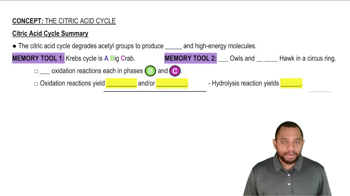Complete the following net equation for one turn of the citric acid cycle.
Acetyl CoA + __H2O + 3 NAD+ + FAD + GDP + ____ ⭢ CoA + ___NADH + ___H+ + FADH2 + GTP + ___CO2
 Verified step by step guidance
Verified step by step guidance Verified video answer for a similar problem:
Verified video answer for a similar problem:



 :50m
:50mMaster Phase A - Citrate Formation Concept 1 with a bite sized video explanation from Jules
Start learning